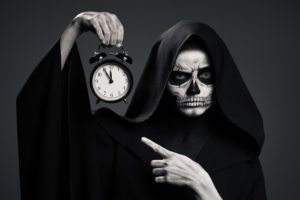Dear readers, it is time to learn a little about the mysteries that death accepts. Essentially, it is a terminal effect that results from the extinction of the hemostatic process in a living being and, along with it, the end of life.
It can occur due to natural faults (old age, illness, consequence of the trophic chain, natural disasters, etc.), or induced ones (suicide, homicide, euthanasia, accident, environmental disaster).
All these factors can be the causes of death. The process of death, although it is totally defined in some of its phases from a neurophysiological point of view, is still little known.
How did Christian sculptors express death?
Most Christian sculptors represented death in the figure of a skeleton, wielding a scythe and, sometimes, by also carrying an hourglass or other weapons.

The stuccoes painted it with a horrible face, under a head of Gorgon bristling with snakes, or in figures of rabid wolves. The most common of the allegories of this divinity among Romans was a sad and immobile genius with a torch turned off, and turned backward.
Hellenes gave it a much less lugubrious aspect, according to an emblem found in some carnelian. It is a winged foot near a caduceus and, on top, a butterfly that takes flight. In classical Greece, one of the main themes of Plato’s work Phaedrus is death precisely.
Death can be defined as an event resulting from the organic inability to sustain homeostasis.
Evolution of the estimation about the state of being dead
In the 20th century, death was defined as the cessation of cardiac activity, absence of pulse, absence of reflexes, and visible respiration. However, based on this insufficient evidence, some people were considered inhuman when living in a latent state or affected by periods of catalepsy.
Years later, thanks to the technological advances and to the better knowledge of the cerebral activity, this evidence proved to be insufficient since the phenomenon of an absence of bioelectric activity, in some exceptional cases, could be reversible as in the case of the drowned people and given by death, in waters at the edge of the freezing point.
Forensic medicine
Historically, attempts to define the precise moment of death have been problematic. In the past, death was defined as the moment when the heart beating and breathing ceased; but the development of science has made it possible to establish that death is really a process which, at certain moments, becomes irreversible.
Today, when a definition of the moment of death is needed, it is considered that it corresponds to the moment when this process is irreversible. There are protocols in medicine that allow establishing with certainty the moment of death. That is to say, that a sufficient and necessary condition for the irreversibility of the death process has been completely fulfilled.
Death is something very hard for all those who have been through such a moment and after death comes the saddest moment of the whole funeral.
Costa Rican funerals are very serious and, at the same time, sad business. When someone dies, the process starts almost immediately and people around the world receive the news, almost at breakneck speed, because there is no embalming process.
In our country, if the deceased person has relatives who live far away, they are likely to miss the funeral all together since generally people are buried no later than the day after. If his/her relatives need to preserve the body, until other relatives arrive in, they will keep it as fresh as possible in a cold storage unit. Also, they can embalm it, but this procedure will cost extra money.
Depending on the type of death, the treatment will be different. For example, if an elderly or sick person dies at home or in the hospital, then a doctor comes and simply writes a death certificate, usually without performing an autopsy.
The deceased’s family is responsible for hiring all post-mortem services, especially the mass and flower tributes, at a local funeral. His/her family selects among the different types of coffins, including some with fake skins. On the other hand, family members, if necessary, usually dress the deceased and can make him/her up, unless the gravedigger does it, which is not very common these days.

His/her family is also responsible for writing an obituary. These come out in big ads in the back of the newspaper “La Nación” and even after the news announcements on Channel 7, with some peaceful music so everyone knows. This alternative is just in case they had not received a personal phone call.
Depending on who has died, the size of a funeral is determined. Usually, large funerals are made up of large extended families, co-workers, and friends. Sometimes, if the person was a government worker, entire municipalities will come out to honor one of their own.
Particularly, when the body is returned, family and close friends have an observation service that they use to call a “candle.” Even neighbors go out to see who has died and pay their respects. These services tend to be very crowded.
Only in severe cases, when the body has been destroyed or when the deceased has requested that his/her body should not be seen by others, it is not shown. In “candles”, people usually cry, sing, remember old times with the deceased, tell old stories, and pray when asked to.

